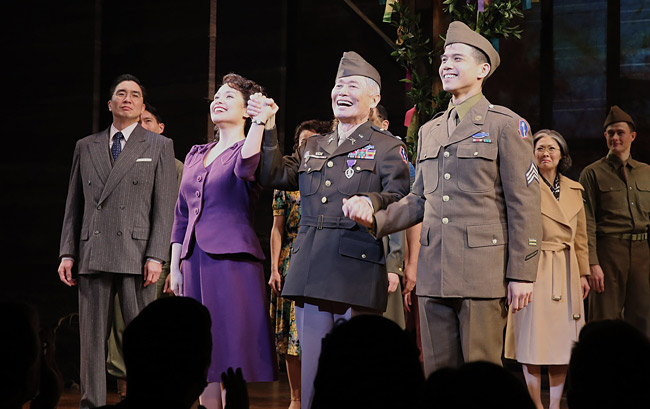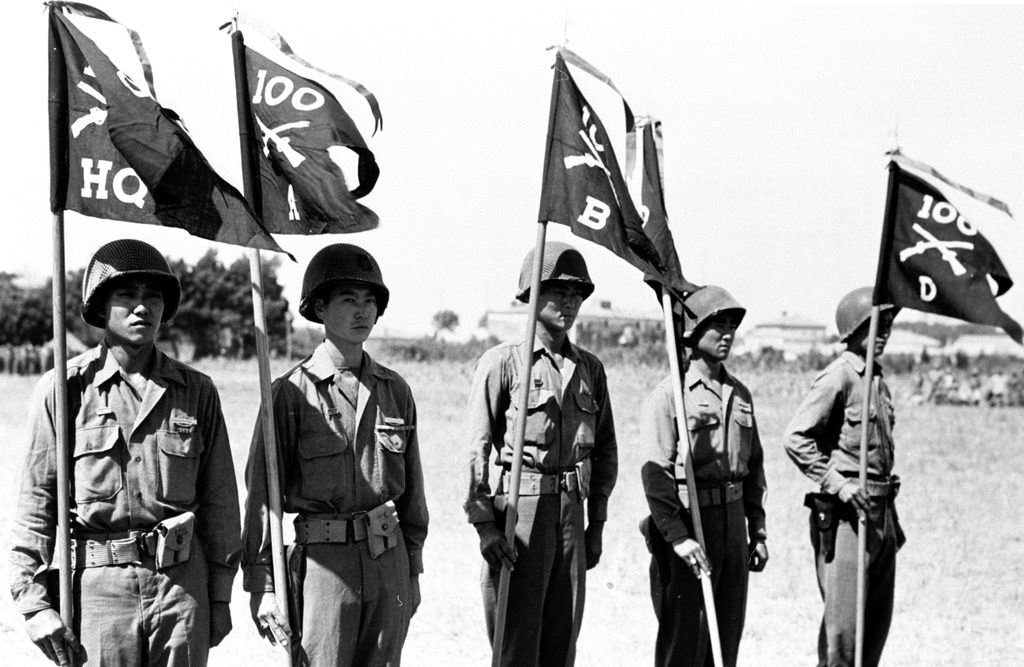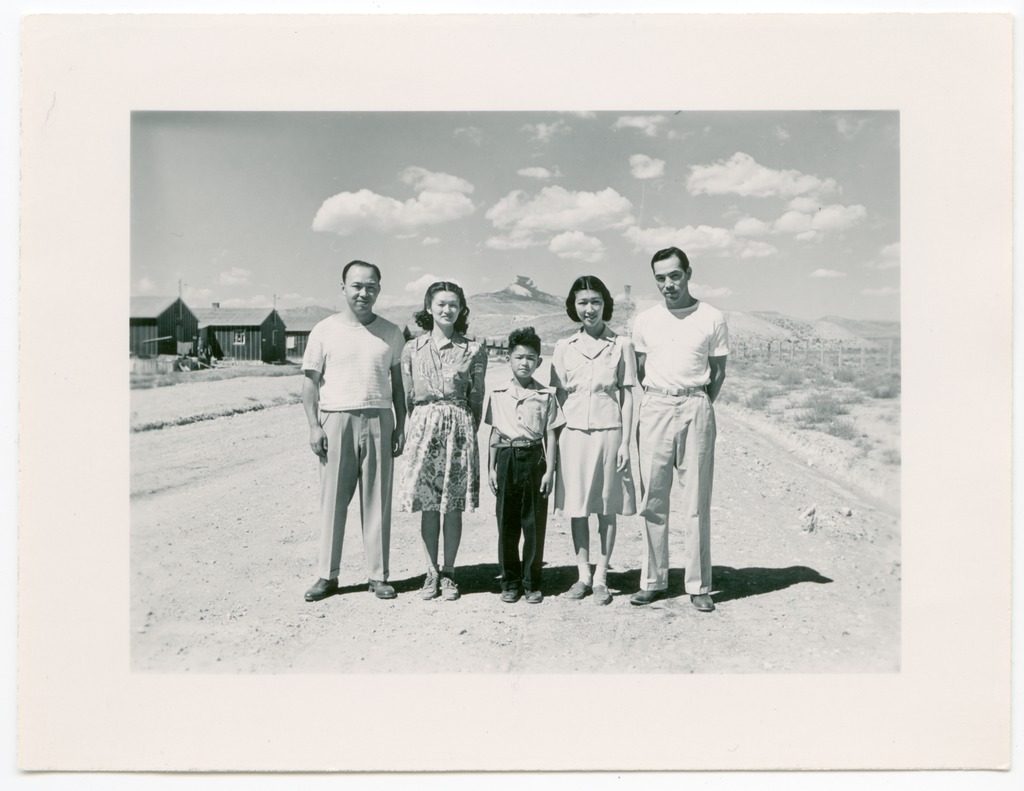February 10, 2017
The timeliness of the subject matter and George Takei’s involvement has helped the play to garner some attention, but both mainstream critics and Japanese Americans have rendered split verdicts on the play. Having seen a filmed version of the play, I find myself just as split, glad that the play exists, enjoying it on one level, but frustrated that it isn’t better.
According to publicity about the play, its origins stemmed from a chance meeting between Takei and husband Brad Takei and Jay Kuo and Lorenzo Thione on consecutive nights in the audience at two Broadway shows. The resulting conversations resulted in a creative collaboration on a musical based on the Japanese American World War II experience. The first staged reading of Allegiance took place in July 2009 at the Japanese American National Museum. Having recruited Tony Award-winning star Lea Salonga, a July 2011 workshop in New York took place as a precursor to the play’s premiere at the Old Globe Theater in San Diego on September 19, 2012. Takei’s canny use of social media helped raise support and funding for the play. Based on both largely positive reviews and strong ticket sales, the producers successfully mounted a Broadway production. Opening on November 8, 2015 at the Longacre Theater, Allegiance was performed 111 times before closing on February 14, 2016. As Takei states in the introduction to this filmed version, about 120,000 people saw the play during its run. After the play closed, a film of a performance of the play screened nationwide last December.

Written by Marc Acito, Jay Kuo, and Lorenzo Thione with music and lyrics by Kuo, Allegiance is largely set in Heart Mountain and centers on the Kimura family, which is torn apart by tensions brought on by their wartime confinement. The play begins in 2001, when an old man named Sam Kimura (played by Takei) is informed that his sister Kei, whom he hasn’t seen for fifty years, has passed away. We then follow Sam back in time to learn why. Just prior to the war, the Kimuras run an apparently prosperous farm in Salinas, California. Having just graduated from college, the young Sam (played by Telly Leung) returns home to his Issei father Tatsuo (Christopheren Nomura), his beloved older sister Kei (Lea Salonga), and his paternal grandfather (also Takei), known only as “Ojii-san.” Their lives are overturned by the war and their subsequent forced removal and incarceration at Heart Mountain. While the Suzukis are fictional, the real historical figure Mike Masaoka (Greg Watanabe) appears periodically providing explanations of the historical events and his perspective on what should be done.
While Sam takes a leadership role in the camp and tries to make the best of the situation, Kei meets a young law student named Frankie Suzuki (Michael K. Lee) who is more cynical and who takes a dim view of Sam’s actions. Sam meanwhile become romantically involved with a Hannah, a white nurse (Katie Rose Clarke) in the camp. The family first splits over the “loyalty questionnaire,” as Tatsuo angrily answers no-no and is sent to Tule Lake. Meanwhile, when the 442nd Regimental Combat Team forms, Sam eagerly signs up. While Sam becomes a war hero in Europe, Frankie becomes a leader of the draft resistance movement in Heart Mountain, which indirectly leads to Hannah’s death. The break becomes final when Sam returns home to find that Kei has married the “traitor” Frankie and subsequently breaks off all ties. Having blocked off memories of that time, Kei’s death now forces the old Sam to come to terms his past.

Before we go any further, let me add this: it was thrilling to see a nearly all Asian American cast on a Broadway stage performing a story about the central episode in the history of Japanese Americans. It is unfortunately still rare to see Asian American-centered stories at the forefront of major cultural forms such as Hollywood movies, Broadway plays, or major network TV shows, and even rarer when the story doesn’t involve a white male lead character (as in Snow Falling on Cedars or Come See the Paradise). As for Broadway, we have to go all the way back to Flower Drum Song (both the original and its 2000s revival) for anything comparable.
I also found the story moving and its ultimate resolution to ring true on an emotional level. Though some of the specifics may be off (much more on this later), I’ve known Nisei like Sam and seen how the years and changes in the political environment have led to a new openness to the past in old age. Though I found the songs unmemorable—leaving the theater, I had trouble recalling any of them in particular—I enjoyed the performances, particularly Salonga’s powerhouse vocals. On the one hand, it is hard to imagine the show without her; on the other hand, I didn’t really buy her as a young Nisei woman, and I was always aware I was watching LEA SALONGA and not Kei Kimura.
I was also pleasantly surprised at the quality of the film production. I was expecting just a filmed play performance with a static long view. Instead, we get a polished production, with close-ups, long shots, and movement. While the lighting and audience reaction make it clear that we are watching stage performance, the overall effect is closer to that of a movie or TV show.
But of course there are issues.
After the San Diego performances in 2012, many Japanese Americans found fault with two major elements of the play. In that version, Mike Masaoka was effectively the villain of the piece. While professional historians have indeed come to portray Masaoka in a largely unfavorably fashion in recent decades, it is also true that Masaoka did not sign EO 9066 or decide that all Japanese Americans had to be removed from the West Coast. Having a Japanese American as the core villain and not FDR, John DeWitt, Karl Bendetsen, or others just seemed off. Indeed, “Concerned [Japanese American] Supporters of ‘Allegiance,'” and the president of the Japanese American Veterans Association, among others, objected to the portrayal of Masaoka and the JACL at that time.
The second major element was the actual portrayal of life in the camps. As most exhaustively chronicled by Frank Abe in his writings on Resisters.com, the play exaggerates the details of the incarceration to make it worse than it really was. As he correctly points out, the producers “invent military rule at Heart Mountain.” He adds:
“… the makers of “Allegiance” selectively alter the reality governing Heart Mountain to more closely suggest that of a German POW camp — complete with camp-wide loudspeakers ordering a nighttime curfew, military police shoving Nisei to the ground, evacuees sorted by gender upon arrival and told to strip to their underwear, and Issei clapped into handcuffs for answering no-no on the loyalty oath.”
Abe concludes, “It’s laughable nonsense, as if the camps were run not by Dillon Myer and the WRA but by Hermann Göring and his Luftwaffe.”
In a nutshell, life in Heart Mountain is portrayed as a combination of Tule Lake, the “assembly centers” (which were run by the army), and a POW camp or prison.
The Broadway version makes two major changes to the San Diego version, both of which address the first criticism. In the Broadway version, the Masaoka character no longer sings and dances, and his words are largely faithful to Masaoka’s actual statements. He is also seen at times discussing the treatment of Japanese Americans with an identified white official, which at least suggests that he is reacting to governmental policies rather than setting them.
There is also a major change to the ending. Without giving it away, I can say that the resolution in the San Diego version is largely political and has to do with Sam’s views of the JACL and his military service. In the Broadway version, the resolution is purely personal, and has to do strictly with his views toward his estranged family. Both changes, I think, are improvements.

Unfortunately, the portrayal of Heart Mountain as a prison camp patrolled by armed guards who beat and handcuff the inmates remains. In addition to the many details about Heart Mountain the play gets wrong and its faulty portrayal of the draft resistance movement, there are even a few more issues that I can point out.
As is the case with many (most?) fictional depictions of removal and incarceration, the prewar home of the Kimuras and the site of their subsequent incarceration don’t match up. As prewar residents of Salinas, they would have gone first to the Salinas Assembly Center and then to Poston. The Heart Mountain population was mostly made up of people from Los Angeles with smaller numbers from Santa Clara or central Washington. Understanding that the producers wanted to set the play in Heart Mountain to draw on the draft resistance movement there, why not have the Kimuras’ farm be in LA County?
So as not to clog up things here, I’ve included a full list of other historical issues as an addendum below.
I certainly understand that this is fiction, and that we shouldn’t hold it to the same standard as we do for documentaries or other non-fictional forms. At the same time, isn’t there a limit, some point where things veer too far from what really happened, to say that maybe we shouldn’t support the work, that it would have been better if had not been made?
There are really two parts to this question, I think. The first is whether knowledge of the historical issues spoils one’s overall enjoyment of the play. As someone who has a high tolerance for such issues, as long as the overall message is a good one—I can even reluctantly recommend things like Danielle Steel’s camp novel, Silent Honor, which ironically suffers from some of the same problems as Allegiance—my answer, is no, as noted above. I did still enjoy the play. But if you know the history, your reaction may well be different. I do think it is important for those of us who know the history to note the issues, which is partly why I am writing this.
The second part of the question is whether these issues make it unsuitable as an introduction to the story or as an educational tool. The danger here is that the inaccuracies provide fuel to those who would justify the incarceration, a population that is no doubt being emboldened by current events. Such concerns have to be weighed against the reach and publicity of a project like this in bringing the story to a wider audience. Again, I tend to think the plusses here outweigh the minuses.
In the end, though, I find myself asking “why”? Takei and the producers certainly know the history—why the need to add in all of these made-up elements? Weren’t the real events of the removal and incarceration dramatic enough? Though I’m still glad it exists and want people to see it, I wish my reaction could be more unequivocally positive.
Historical Issues in Allegiance
Note: this list is based on a single viewing of the filmed play; thus, I’m sure there are things I have missed, and there may well be things I got wrong. If you have anything to add, please do so in the comments.
Logistical/timing issues
- Mismatch between prewar home and concentration camp; noted in text above
- Accepting that the Kimuras did to go Heart Mountain, no mention is made of their having gone to an “assembly center” beforehand, as pretty much all who went to Heart Mountain did
- All Japanese Americans are apparently removed from the West Coast on the same day (The actual removal took place in piecemeal fashion through 108 exclusion orders issued over a period of five months.)
- On the days they are removed, the Kimuras are issued tags that already say “Heart Mountain” on them; while tags were issued, they did not include a destination, and, as noted above, the Kimuras would have first gone to an “assembly center” anyway
- As they answer the “loyalty questions,” inmates know they will be sent to Tule Lake if they give “no” answers. In reality, inmates did not know what their fate would be when replying “no” to questions 27 and 28.
- Frankie seems to be drafted in August 1944 and starts the draft resistance movement after that; the actual Heart Mountain Fair Play Committee organized in February 1944.
Heart Mountain as prison camp issues
In the War Relocation Authority (WRA) administered camps, there was a clear division of labor between the army and WRA, with the former in charge of the perimeter (including the infamous guard towers) and with ingress and egress, while the latter ran everything on the inside. Included in the WRA’s charge was security within the fences, usually assigned to a white staff member with largely Japanese American inmates in support positions.
With the exception of two instances of martial law (during unrest at Manzanar and Tule Lake), the military police did not enter the WRA camps. Thus, the interactions between MPs and inmates as depicted at Heart Mountain could not have happened as portrayed. These include:
- the strip search of inmates upon arrival at Heart Mountain
- MPs rudely quashing any hints of Japanese culture in the camps
- a scene in which an MP pulls a gun on Sam
- when Sam’s father answers “no-no” on the loyalty questionnaire, MPs handcuff him and lead him away
- Frankie is beaten up the “stockade” and carried away at gunpoint; while inmates at Tule Lake were held in a stockade and sometimes beaten, there was no stockade at Heart Mountain
- MPs open fire on Frankie when they think he is trying to resist
- MPs shoot a and kill a white WRA employee,
Draft resistance issues
There was an organized resistance to the draft at Heart Mountain under the Heart Mountain Fair Play Committee (FPC), the only such organized resistance in any of the ten WRA camps. One of the leaders of that resistance, Frank Emi, may have been a model for Frankie, though beyond draft resistance and a first name, they share little in common.
The core problem here is the portrayal of the movement as a secret and underground one. The real FPC held meetings in the open and distributed literature in camp. Their activities were covered (negatively) in the camp newspaper, the Heart Mountain Sentinel. There is also a scene in which Kei and others who write letters in support of Frankie have to dodge censors and have to smuggle out the story of the resisters. Mail at WRA camps was not censored (mail to and from the enemy alien detention camps run by the army and INS was censored), and the activities of the resisters was known by those outside and covered in newspapers on the outside.
—
By Brian Niiya, Densho Content Director
